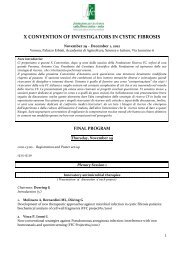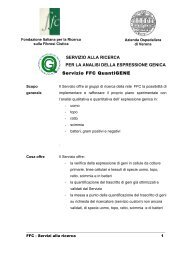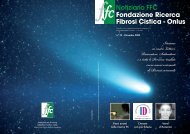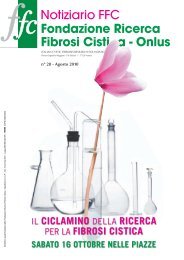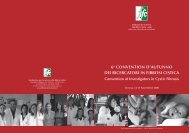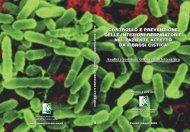Brochure Seminario di Primavera 2005 - Fondazione Ricerca ...
Brochure Seminario di Primavera 2005 - Fondazione Ricerca ...
Brochure Seminario di Primavera 2005 - Fondazione Ricerca ...
Create successful ePaper yourself
Turn your PDF publications into a flip-book with our unique Google optimized e-Paper software.
William B. Guggino<br />
Johns Hopkins University School<br />
of Me<strong>di</strong>cine, Baltimore, USA<br />
Il Dr William Guggino è professore <strong>di</strong> Fisiologia e<br />
Pe<strong>di</strong>atria presso la Johns Hopkins School of<br />
Me<strong>di</strong>cine <strong>di</strong> Baltimora. Egli ha rivestito e riveste<br />
parecchi incarichi <strong>di</strong> <strong>di</strong>rezione <strong>di</strong> ricerca, tra cui:<br />
Centro <strong>di</strong> Terapia Genica della Fibrosi Cistica presso<br />
l’NIH, Centro Specializzato <strong>di</strong> <strong>Ricerca</strong> per la Fibrosi<br />
Cistica sempre al NIH, vice <strong>di</strong>rettore <strong>di</strong> Ricerche in<br />
Pe<strong>di</strong>atria presso la J. Hopkins University School <strong>di</strong><br />
Baltimora.Grande esperto nelle tecniche <strong>di</strong> biologia<br />
molecolare, i suoi interessi <strong>di</strong> ricerca più recenti<br />
riguardano: <strong>di</strong>agnosi, patogenesi e trattamento delle<br />
malattie genetiche nei bambini; ruolo della CFTR<br />
nello sviluppo dei polmoni e funzionamento dei<br />
canali del cloro; meccanismi <strong>di</strong> trasporto tubulare<br />
renale, con particolare interesse per le interazioni<br />
proteiche nella secrezione <strong>di</strong> flui<strong>di</strong>; interazione tra<br />
proteina CFTR ed altre proteine nella maturazione e<br />
funzionamento <strong>di</strong> CFTR; nuovi approcci farmacologici<br />
per mo<strong>di</strong>ficare l’espressione e la maturazione <strong>di</strong><br />
CFTR; biologia molecolare della CF in generale; trial<br />
clinico con duramicina.<br />
10<br />
DIFETTO DI BASE<br />
Acquisizioni sulla macchina<br />
secretiva epiteliale<br />
e prospettive <strong>di</strong> terapia<br />
del <strong>di</strong>fetto base CF<br />
CFTR, a Cl- channel that is regulated by phosphorylation<br />
and ATP hydrolysis, is localized at the apical<br />
membrane in secretory epithelia such as the<br />
conducting airways and in the apical and basolateral<br />
membrane of the sweat duct. CFTR me<strong>di</strong>ates<br />
ion and water transport across the epithelial barrier<br />
1. A number of ion channels work in concert<br />
with CFTR. These include outwardly rectifying<br />
chloride channels (ORCC), epithelial so<strong>di</strong>um channels<br />
(ENaC), and inwardly rectifying potassium<br />
channels (ROMK2) (see 2 for a review). CFTR is also<br />
functionally associated with signal transduction<br />
enzymes 1. The functional interaction of CFTR with<br />
other proteins suggests that CFTR may be physically<br />
associated with these proteins.<br />
Ion channels in neuronal tissues are not <strong>di</strong>ffusely<br />
<strong>di</strong>stributed throughout the neurons but are rather<br />
localized and clustered at specialized subcellular<br />
site such as presynaptic and postsynaptic membranes.<br />
Scaffol<strong>di</strong>ng proteins that contain PDZ<br />
domains typically bind to the C-terminus of ion<br />
channels and organize them in three-<strong>di</strong>mension<br />
complexes at these locations 3. PDZ domain is a<br />
modular protein interaction domain consisting of<br />
80-90 amino acids. It was originally identified in<br />
post-synaptic density protein PSD95, drosophila<br />
tumor suppressor Dlg and epithelial tight junction<br />
protein ZO-1 3. In ad<strong>di</strong>tion to targeting channels<br />
and receptors to the specialized membrane, the<br />
action of scaffol<strong>di</strong>ng proteins organizes the related<br />
signaling molecules into macromolecular complexes.<br />
For example, the PDZ protein InaD localizes<br />
the transient receptor potential (TRP) channel to<br />
the rhabdomere, and assembles TRP into a functional<br />
protein complex with signal transduction<br />
molecules 4.



